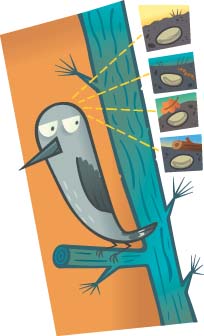 |
 |
| current issue |  |
past issues |  |
send a letter/news |  |
address update |  |
advertise |  |
about us |  |
alumni home |
by Suki Casanave '86G
Illustrations by Jim Paillot
In this issue:
Total RecallBabes in the Bay
Methane Mud
Total Recall
This bird never forgets

|
Fitz is a bird with a mission. Inside the front chamber of a small wooden box, he is pacing about, stopping frequently to rap his curved beak against a shiny metal door. When the door opens, he heads straight for a black tube, pushes aside the top with his beak and reaches in for his reward--a pine nut. The light goes off. The door lifts. Fitz returns to the front chamber. And then it starts all over again.
Fitz's "coach" for this exercise, which he repeats 24 times each afternoon, is graduate student Maria Clara Zoccoli '07, who works under the guidance of Brett Gibson, assistant professor of psychology and an expert on the remarkable bird known as Clark's nutcracker. A member of the highly intelligent Corvid family, which includes crows and ravens, the nutcracker buries tens of thousands of pine nuts each year in as many as 8,000 locations throughout a 15-square-mile area. During the winter, the bird retrieves the nuts, its very survival dependent on the accuracy of its memory. Gibson, who specializes in animal behavior, hopes to explain how the nutcracker pulls off this amazing feat.
Recording Fitz's choices is the first step in an experiment designed to test the bird's meta-memory--an awareness of its own cognitive skills. The answer might provide one small piece of the puzzle Gibson is trying to solve. "People can tell us what's going on inside their heads," notes Gibson. "Birds can't. We're trying to figure out what's in there by observing what they do."
Another of Gibson's students, Tyler Wilks '03, '06G, is working with six other nutcrackers. Two years ago, Wilks' father helped his son build a 12-sided enclosure he now uses for research. The small room consists of 12 identical panels of smooth white melamine. "Shut the door, close your eyes, spin around and you'll be disoriented in no time," says Wilks.
Every day, Wilks releases his birds, one at a time, into the chamber, videotaping and then gathering data on two things: the birds' ability to use landmarks to find a buried pine nut and their ability to achieve the same thing without any landmarks at all, using their internal sense of direction.
"We're trying to understand how the birds create a cognitive map of where everything is," says Wilks. "Ultimately, it might help us know more about how human beings organize their environment into a mental map." The research may also contribute to the understanding of memory and memory-related disorders in humans, such as Alzheimer's disease.
Thanks in part to his students' help, Gibson juggles a host of research projects while concocting new and clever experiments on the memory abilities of this remarkable bird. Says Zoccoli, "It's the hope of finding something that keeps you going."
Babes in the Bay
Oysters on the rebound
Last summer, Cody and Carol Cartnick became the proud parents of about 2,000 oyster babies. The "spat," as young oysters are called, resided in a modified lobster trap suspended from the Cartnicks' dock in the waters of New Hampshire's Little Bay. For three months, the couple kept close watch on the tiny, fingernail-sized offspring, measuring their size, recording mortality rates, cleaning algae from the cages and clearing out predator crabs. "It got personal," says Cody Cartnick. "They were our babies." The goal: to raise their young charges into healthy well-adjusted juveniles that could be returned to their natural habitat on the bottom of the bay.
The Cartnicks are among more than two dozen citizen-scientists who participated in UNH's new oyster conservationist program aimed at helping to restore the once-thriving oyster population in Great Bay. The bivalve mollusk population has declined steadily since the 1800s, due in part to harvesting. In 1995, the oysters were hit by a protozoan parasite commonly known as MSX (multinucleated sphere unknown) and the population plummeted. "Today, we're down to less than 10 percent of what we had even 10 years ago," says Raymond Grizzle, associate research professor of zoology, who spearheads the Oyster Restoration Program, a collaborative venture that includes NOAA and the Nature Conservancy. The average number of oysters per square meter is now fewer than 25, says Grizzle. The goal in the restored reefs is about 200 oysters per square meter, enough to sustain an ongoing healthy oyster population.

|
While plenty of people have a passion for the oyster as a culinary delicacy, fewer are aware of its ecological importance. Constructed of thousands of individual oysters cemented together, oyster reefs form complex three-dimensional structures that provide a habitat for many species of fish, invertebrates and plants. Oysters are also champion filter feeders, which means they perform a water-filtering function. A single oyster can filter 20 gallons of water each day. According to a recent study published by the Nature Conservancy and UNH, before the recent drastic losses, the oyster population could filter the entire volume of Great Bay in less than four days; at current population levels, it would take more than four months.
Launched in 2000, the Oyster Restoration Program has helped to re-establish five beds in the Great Bay area. The oysters in these new beds are about five times as dense as those in the surrounding natural areas. "They are starting to reproduce on their own," says Grizzle.
But there's still a long way to go. "Our reefs are severely decimated," says Jennifer Greene '00, '04G, supervisor of laboratory research. Grizzle says the oyster is one of the most valuable species because of all the ecological functions it performs--and because of its value to humans. "That's why I do this work."
Methane Mud
Wetlands produce their own greenhouse gas
On an early winter day, Jordan Goodrich '07 is bundled up against the cold, hunkered down on the shifting earth of Sallie's Fen in Barrington, N.H. Syringe in hand, the environmental science major extracts methane gas from a clear Teflon box that has been resting on top of a 3-foot-square patch of wetlands for the past hour. He repeats this procedure six or seven times throughout the day, then heads for the lab back at UNH to run the samples through a gas chromatograph.
Goodrich's weekly forays to the fen are part of history in the making. Launched 17 years ago by Patrick Crill, then- director of UNH's Complex Systems Research Center, the study underway in this southern New Hampshire wetland has produced a valuable slice of scientific history. "It's the only wetlands field site with such a long-term record of methane flux data," says Ruth Varner '93G, '00G, a research assistant professor who now heads the project. Varner worked on Sallie's Fen as a graduate student; today students like Goodrich and others continue the work under her guidance.

|
"Globally, wetlands are the largest natural producers of natural methane gas," says Varner. Less abundant than carbon dioxide, the most famous of greenhouse gases, methane has its own claim to fame: It has a global warming potential of 23, which means that a ton of methane in the atmosphere can cause 23 times more warming than the same mass of carbon dioxide. "Small changes in sources of methane can therefore have a huge impact on the atmosphere," she says.
That's why it's important to pay attention to our production of the gas. There is ample evidence that humans have a real impact. In years when there has been lots of burning--massive wildfires or fires to clear land for agriculture, for example, methane in the atmosphere has gone up markedly, according to Varner. In addition, "changes in atmospheric methane in the last decade coincide with the changing economies of industrialized countries," she says.
The research in Sallie's Fen will provide critical data for scientists creating models of climate change. "It will help them to make better predictions," says Varner. "Unless we understand natural ecosystems, how they emit gases and take them up, we can't be confident in our model results, and we can't predict how those natural systems will respond to climate change."
Researchers are after answers to big questions about worldwide climate change: What might happen if the world's temperatures increase? Will wetlands dry out? If so, will methane increase because of increased temperatures? Varner and her team will be looking at the Sallie's Fen data asking these same questions. "The fen will provide a baseline of natural production," says Varner.
The years of carefully gathered data will help reveal the science underlying Earth's highly complex systems, the science that helps build the models that can become, ultimately, the foundation of policy--policy that can create change for the better.
blog comments powered by Disqus

